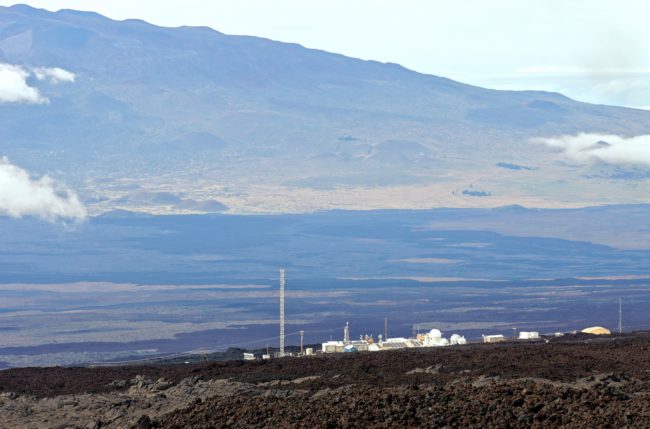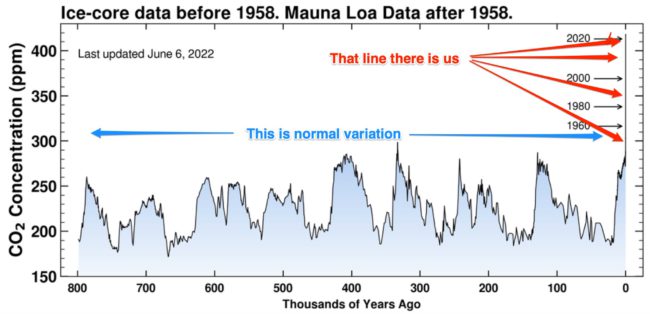
Far out in the Pacific ocean located on the Hawaiian island of Mauna Loa is the Mauna Loa Observatory. That’s it pictured above. Since 1958 daily measurements of the CO2 within our atmosphere has been carefully collected from there.
It was setup and run by scientist Charles Keeling, and has been in continuous daily operation. The location is at the 11,145 ft level on Mauna Loa’s north slope about three miles north of the summit.
Why here?
It is far from any continent so the air that is sampled is a good average for the central Pacific. It is also located high enough to be above the inversion layer where air pollution can be trapped. In other words minimal false readings. Oh, and there was already a rather handy road there that had been previously built by the military.
It truly is the sweet spot for gathering data and so there are other facilities such as the Mauna Loa Solar Observatory. It is also currently a temporary home to a cosmic microwave background observatory called AMiBA.
Because Charles Keeling initiated this collecting of CO2 data, the line drawn on a chart that represents the measurements has become known as the Keeling Curve.
Here are the latest measurements.
Keeling Curve – June 6, 2022

The first point to note is that it is not a straight line, but instead fluctuates up and down on a seasonal basis. This happens because land vegetation within the Northern hemisphere flourishes over the summer, hence absorbs CO2. Since most of the land on the planet is in the Northern hemisphere that’s where most of the planetary vegetation exists, hence we have this seasonal variation by roughly 5 ppmv each year.
The second rather startling observation is the rate of increase of the line. Starting with an initial measurement of 313 parts per million by volume (ppmv) in March 1958 we can see that it has now risen to 421.18.
It is still increasing.
Today’s reading is a new record. You are breathing a mixture of air that was previously unknown to our entire species.
But it’s only tiny, this is not a big deal … right?
Sadly no, this really is a very big deal.
CO2 is what is known as a greenhouse gas. It absorbs and emits infrared radiation.
Rather obviously the primary source of energy is the sun and for that there exists an energy balance.
What does that mean?
We receive energy from the sun and we also emit energy back out into space. The difference between those, the energy we keep, is referred to as the energy balance.
If you increase CO2, which as a greenhouse gas, more energy is trapped and so you change that energy balance.
In other words, climate change denial is not a difference of opinion, but rather is an argument some deniers are having with the laws of physics. That’s not an argument anybody can ever win.
We have a seasonal variation, don’t we also have other longer term variations?
Sort answer – actually yes, we do, but it is nothing like now.
Longer answer, we have data for CO2 that goes back over the last 800,000 years.
Ice cores drilled in Greenland and also the Antarctic come with tiny bubbles of trapped air from a long time ago. That enables us to measure the CO2 going back that far.
Put that together with the Keeling data and this is what you get …

Why do we see that normal variation, what causes that?
The orbit of earth around the sun does not stay exactly the same. It varies.
There are other huge planets in the solar system that exert a gradational tug upon us and so as a result our orbit around the sun varies from an almost perfect circle to an eclipse. These normal cycles are called Milankovitch cycles. They got that weird name because Serbian geophysicist and astronomer Milutin Milanković was the first to have the hypothesis in the 1920s that this was responsible for long-term climate variations.
Basically, as you can see from the above chart, our orbital variations will increase and decrease the amount of solar radiation we receive and so that causes the amount of CO2 within our atmosphere to naturally oscillate as we bump in and out of ice ages roughly every 100,000 years.
What you can also see from the chart is that we have now broken and disrupted that cycle.
Our extremely rapid increase of CO2 has put our entire planetary climate system into uncharted territory.
There is an old joke inspired by Kipling’s 1895 poem “If”. It goes something like this – If you can keep cool and remain calm while everybody around you is running around screaming in raw panic … then there is clearly something going on that you have failed to grasp.
The scientific community, and more specifically climate scientists, those that deeply grasp what is actually happening and what we are doing via our fossil fuel emissions because they have access to all the data are freaking out.
There really is no ducking this in the long term.
Climate change is the greatest threat our species will ever face.
NOAA Press Release June 3, 2022
With yet another record high for CO2 measurements within our atmosphere, NOAA issued a press release a few days ago …
Here are a few extracts from that statement …
…“The science is irrefutable: humans are altering our climate in ways that our economy and our infrastructure must adapt to,” said NOAA Administrator Rick Spinrad, Ph.D. “We can see the impacts of climate change around us every day. The relentless increase of carbon dioxide measured at Mauna Loa is a stark reminder that we need to take urgent, serious steps to become a more Climate Ready Nation.” …
…CO2 levels are now comparable to the Pliocene Climatic Optimum, between 4.1 and 4.5 million years ago, when they were close to, or above 400 ppm. During that time, sea levels were between 5 and 25 meters higher than today, high enough to drown many of the world’s largest modern cities. Temperatures then averaged 7 degrees Fahrenheit higher than in pre-industrial times, and studies indicate that large forests occupied today’s Arctic tundra…
…“It’s depressing that we’ve lacked the collective will power to slow the relentless rise in CO2,” said Keeling. “Fossil-fuel use may no longer be accelerating, but we are still racing at top speed towards a global catastrophe.”…
… “Carbon dioxide is at levels our species has never experienced before — this is not new,” said Pieter Tans, senior scientist with the Global Monitoring Laboratory. “We have known about this for half a century, and have failed to do anything meaningful about it. What’s it going to take for us to wake up?”
To visualize how sea level rise may affect your community, visit NOAA’s sea level rise viewer, at: https://coast.noaa.gov/slr/
In Summary
CO2 levels via our fossil fuel emissions are still rising, and have now reached a new record high. If we don’t change that then we as a species are truly fu*ked.
We have most probably already committed ourselves to a very different planet.
We do still have choices.
If we strive to do so, then we can perhaps slow things down enough to gain enough time to adapt. If instead we continue to rush forward, then the changes will come at us so fast that we will not be able to adapt.
